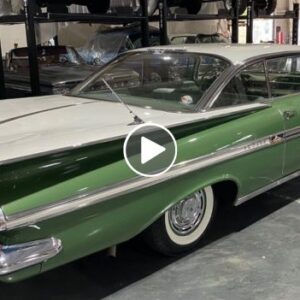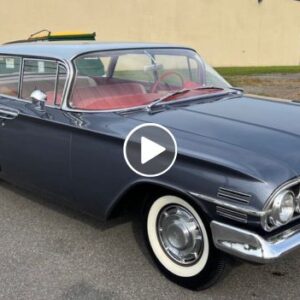
In 1973, a paroxysm of brand-engineering ingenuity led General Motors to fashion more than a dozen nameplates off a single all-new platform called the A-body. Most of them were forgettable products of a dark era in American automotive history. But one of them, the Pontiac Grand AM, lives on as an intriguing artifact of a road not taken.
Although the name suggested a synthesis of the luxury of the Pontiac Grand Prix and the performance of the Pontiac Trans Am, the Grand Am was designed as an American take on the poised handling and elegant interiors of premium European imports. So this Pontiac was equipped with radial tires, a sport-tuned suspension, bucket seats, a beefy steering wheel, and even a Euro-style high-beam switch on a stalk off the steering wheel rather than the usual button on the floor. “Except for the Firebird/Camaro and Corvette,” a contemporary magazine enthused, “there is no car built in America that handles as well as the Grand Am, and certainly nothing at all that comes close to it in size. The car is pure pleasure to drive.”

But what really set the Grand Am apart was its styling. Despite sharing its fundamental shape with the Buick Century, Chevrolet Chevelle, and Oldsmobile Cutlass, the Pontiac is uniquely striking. Just like the Pontiac LeMans from which it is derived, the Grand Am has classic long hood/short rear deck proportions, but a six-piece “catwalk” grille, louvered B-pillars, and a special graphics package have embellished them. Most of all, the Grand Am has a distinctive nose just as every Pontiac since 1959 has had, and its V-shape hood ends in a dramatically sculpted prow. Made of soft, injection-molded urethane that bounces back into shape after a low-speed impact, the nose took the place of
a conventional metal bumper.
“The lines of the car are beautiful,” says John Alden, who owns a 1974 Grand Am that still turns heads whenever he takes it out for a spin, which is just about every day. “And it looks so different from anything else on the road.”

The Grand Am’s base price in 1973 was $4,263.50. This was about $1,000 more than a Pontiac LeMans or an Oldsmobile Cutlass, but it was only half as much as a BMW Bavaria, a Jaguar XJ6, or a Mercedes-Benz 280C. Even loaded with options—including the top-of-the-line 455-cubic-inch (7.5-liter) pushrod V-8, cruise control, A/C, and the must-have eight-track tape player—the final price was less than $6,000.
Ron Berglund, a longtime Pontiac maven in Fresno, California, picked up one of these fully loaded Grand Ams for a mere $500 in 1981. After driving it for two years, he said to himself, “You know what? This is going to be a valuable car someday, so I’m going to restore it.”

Berglund’s baby is now one of the finest Grand Ams in the country. It sits rakishly on 15-inch Rally II wheels, looking proud and vaguely predatory. The mass of the car adds to its presence; Berglund’s two-door coupe rides on a 112-inch wheelbase and weighs 2 tons. (The four-door sedans are even longer and heavier.) The gargantuan driver-side door is almost as large as the hood of a modern Fiat 500.

Anybody familiar with ’60s-style GM interiors will feel at home with the dashboard, trimmed with plenty of wood and lots of dials. (It was lifted from the Pontiac Grand Prix.) But the bucket seats—with adjustable rake and lumbar support!—are a revelation, and the steering wheel’s hefty rim is sporty.

When Berglund cranks the starter, the stumbling lope of the engine signals the car’s major deviation from stock—a hot cam he added to produce some extra oomph. In factory form, his four-barrel V-8 was rated 250 hp with dual exhausts. The base model came with a two-barrel 400-cubic-inch (6.6-liter) V-8, and there was also an optional four-barrel carburetor. Berglund says his car will cruise all day at 80 mph, and he’s seen triple digits on the speedo. The legendarily robust Turbo Hydra-matic has only three speeds, but because the engine and transmission are so well mated, you always seem to be in the correct gear.

The variable-ratio power steering is remarkably precise by the standards of the day, and front and rear anti-roll bars keep the body reasonably well controlled during cornering. Although nobody will confuse it with a 1968-1973 Pontiac GTO, the Grand Am offered a brand of long-legged, Euro-style GT performance that was unique among American cars of its time. It was the logical extension of the 1960s-style muscle car.

The Grand Am found a welcome market at first, and first-year sales were a solid 43,136 units. But the oil embargo of 1973 undercut the appeal of muscle cars, as did the air emissions regulations that followed, and the Grand Am was killed in 1975. The nameplate—sans panache—was revived in 1978, and it survived until 2005, but it never again rose above milquetoast mediocrity. Still, Berglund’s accurately restored 1973 Pontiac Grand Am remains a tantalizing glimpse at what the future of the muscle car might have been.
Purists might argue that the Pontiac Grand Am is neither collectible nor a classic. It lacks the flamboyance of Detroit iron of the 1950s and the audacity of the muscle cars of the ’60s. But the cars of the early 1970s, built before the oil embargoes and Japanese imports rewrote the rules of the game, are the latest—and among the cheapest—models radiating the bedrock confidence of the Big Three, and they mark the end of an era of American supremacy. With production of 70,898 cars during the three-year model run, the Grand Am is relatively rare by American standards. Drivers go for as little as $6,000, sweethearts for closer to $25,000, and $11,000 will get you a memorable time capsule of a bygone age.
For more information about the Grand Am, contact the Pontiac Oakland Club International, www.poci.org, 877-368-3454.






